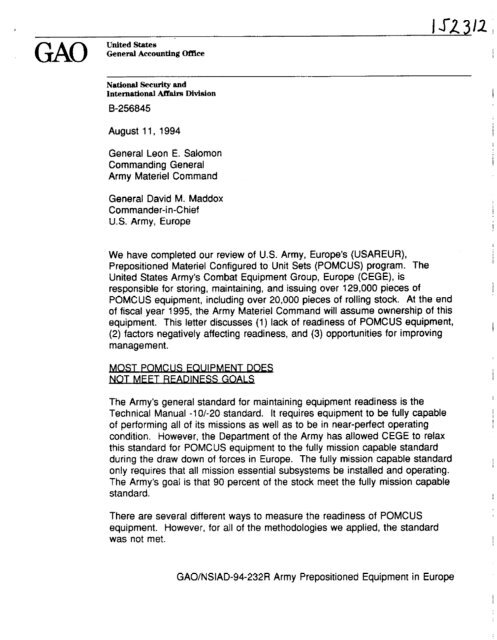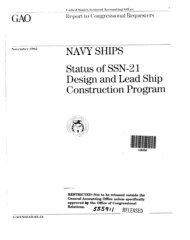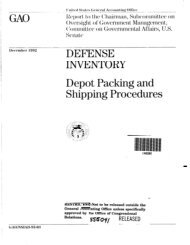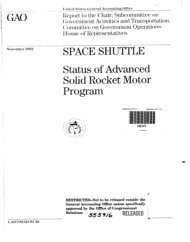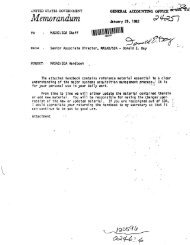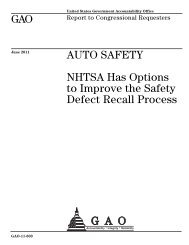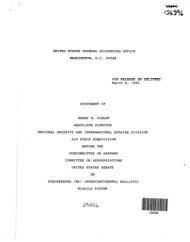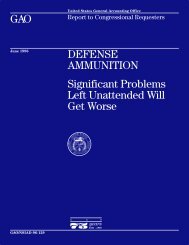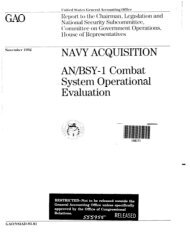NSIAD-94-232R Army Prepositioned Equipment in Europe
NSIAD-94-232R Army Prepositioned Equipment in Europe
NSIAD-94-232R Army Prepositioned Equipment in Europe
- No tags were found...
Create successful ePaper yourself
Turn your PDF publications into a flip-book with our unique Google optimized e-Paper software.
GAOunk8?dststes ’General Account<strong>in</strong>gOf!RceNational Security andInternational Affairs DivisionB-256845August 11, 19<strong>94</strong>General Leon E. SalomonCommand<strong>in</strong>g General<strong>Army</strong> Materiel CommandGeneral David M. MaddoxCommander-<strong>in</strong>-ChiefU.S. <strong>Army</strong>, <strong>Europe</strong>We have completed our review of U.S. <strong>Army</strong>, <strong>Europe</strong>’s (USAREUR),<strong>Prepositioned</strong> Materiel Configured to Unit Sets (POMCUS) program. TheUnited States <strong>Army</strong>’s Combat <strong>Equipment</strong> Group, <strong>Europe</strong> (CEGE), isresponsible for stor<strong>in</strong>g, ma<strong>in</strong>ta<strong>in</strong><strong>in</strong>g, and issu<strong>in</strong>g over 129,000 pieces ofPOMCUS equipment, <strong>in</strong>clud<strong>in</strong>g over 20,000 pieces of roll<strong>in</strong>g stock. At the endof fiscal year 1995, the <strong>Army</strong> Materiel Command will assume ownership of thisequipment. This letter discusses (1) lack of read<strong>in</strong>ess of POMCUS equipment,(2) factors negatively affect<strong>in</strong>g read<strong>in</strong>ess, and (3) opportunities for improv<strong>in</strong>gmanagement.M-T POMCUS FrJUlPMFNT rm=.sThe <strong>Army</strong>’s general standard for ma<strong>in</strong>ta<strong>in</strong><strong>in</strong>g equipment read<strong>in</strong>ess is theTechnical Manual -lo/-20 standard. It requires equipment to be fully capableof perform<strong>in</strong>g all of its missions as well as to be <strong>in</strong> near-perfect operat<strong>in</strong>gcondition. However, the Department of the <strong>Army</strong> has allowed CEGE to relaxthis standard for POMCUS equipment to the futly mission capable standarddur<strong>in</strong>g the draw down of forces <strong>in</strong> <strong>Europe</strong>. The fully mission capable standardonly requires that all mission essential subsystems be <strong>in</strong>stalled and operat<strong>in</strong>g.The <strong>Army</strong>’s goal is that 90 percent of the stock meet the fully mission capablestandard.There are several different ways to measure the read<strong>in</strong>ess of POMCUSequipment. However, for all of the methodologies we applied, the standardwas not met.GAO<strong>NSIAD</strong>-<strong>94</strong>-<strong>232R</strong><strong>Army</strong> <strong>Prepositioned</strong> <strong>Equipment</strong> <strong>in</strong> <strong>Europe</strong>
. .B-256845CEGE ma<strong>in</strong>ta<strong>in</strong>s read<strong>in</strong>ess data for only 21 types of POMCUS equipment.However, it does no? ma<strong>in</strong>ta<strong>in</strong> read<strong>in</strong>ess data on mission essential subsystemsfor these items. Consequently, the true read<strong>in</strong>ess rate of the equipment isunknown. Our review of the data CEGE does ma<strong>in</strong>ta<strong>in</strong> showed that, as ofMarch 19<strong>94</strong>, only 83 percent of the non-excess equipment on-hand wasconsidered fully mission capable (see encl. I). (This equated to approximately48 percent of the authorized stocks because CEGE did not have theauthorized quantity on hand for 8 of the 21 types.) Read<strong>in</strong>ess rates for some<strong>in</strong>dividual POMCUS sites were even tower; at Brunssum, for example, only 66percent of the on-hand equipment for the 21 types of equipment tracked byCEGE was considered fully mission capable (21 percent of the authorizedstocks).At two POMCUS sites, we obta<strong>in</strong>ed and analyzed read<strong>in</strong>ess data for allma<strong>in</strong>tenance significant items (i.e., ail items requir<strong>in</strong>g recurr<strong>in</strong>g ma<strong>in</strong>tenance).This analysis showed that, as of May t9<strong>94</strong>, only 85 percent of the non-excessPOMCUS equipment on-hand (25 percent of the authorized stocks) atBrunssum were considered fully mission capable. At Miesau, the rates were63 percent of the on-hand stocks and 47 percent of the authorized stocks (seeencl. II). At both of these sites, the authorized quantities for all ma<strong>in</strong>tenancesignificant items were based on the 1993 POMCUS authorization document.Another way to assess the overall read<strong>in</strong>ess of POMCUS equipment is todeterm<strong>in</strong>e whether each type of equipment meets the read<strong>in</strong>ess standard. Ofthe 21 types tracked by CEGE, 11 met or exceeded the 90 percent fullymission-capablegoal for on-hand equipment and for each of these types, theon-hand quantity equalled the authorized level. Of the 10 equipment types thatdid not meet the read<strong>in</strong>ess standard, only 2 had their authorized level on-hand.Apply<strong>in</strong>g this analysis to all types of equipment at the 2 sites we visited, wefound that only 49 percent of the equipment types on-hand at 8runssum and34 percent at Miesau met or exceeded the 90 percent fully-mission-capablegoal (18 percent and 27 percent, respectively, based on authorized quantities).COMPETING MISSIONS AND MAINTENANCEPROBLEMS HlNDER READINESS OF POMCUSEQUlPMENTDecisions perta<strong>in</strong><strong>in</strong>g to the use of POMCUS equipment and the disposition ofequipment from deactivat<strong>in</strong>g units have reduced the read<strong>in</strong>ess rates ofPOMCUS equipment and created a large ma<strong>in</strong>tenance backlog. Prior to 1990,2 GAO/<strong>NSIAD</strong>-<strong>94</strong>-<strong>232R</strong> <strong>Army</strong> <strong>Prepositioned</strong> <strong>Equipment</strong> <strong>in</strong> <strong>Europe</strong>
’ .B-256845POMCUS equipment was sent to POMCUS storage sites directly from themanufacturer or from a rebuild<strong>in</strong>g facility. Most of the equipment was stored <strong>in</strong>controlled-humidity warehouses and was only removed for use <strong>in</strong> tra<strong>in</strong><strong>in</strong>gexercises or for cyclic ma<strong>in</strong>tenance.’ However, dur<strong>in</strong>g Operation DesertShield <strong>in</strong> 1990, POMCUS equipment was issued to the Commander-<strong>in</strong>-Chief,U.S. <strong>Army</strong> Central Command, to fill shortages. Much of the equipmentreturned to POMCUS facilities after Operation Desert Storm was badlydamaged and <strong>in</strong> need of major repairs to br<strong>in</strong>g it up to the <strong>Army</strong>’s TechnicalManual -1 O/-20 ma<strong>in</strong>tenance standard.Also, USAREUR has directed CEGE to provide fully mission capableequipment for numerous cont<strong>in</strong>gency missions, <strong>in</strong>clud<strong>in</strong>g Operation RestoreHope <strong>in</strong> Somalia, Operation Support Hope <strong>in</strong> Rwanda, and preposition<strong>in</strong>gprograms afloat and ashore. Draw<strong>in</strong>g this equipment for these missions furtherreduces the read<strong>in</strong>ess of POMCUS equipment.Prepar<strong>in</strong>g equipment for cont<strong>in</strong>gency missions (<strong>in</strong>spect<strong>in</strong>g, repair<strong>in</strong>g, andshipp<strong>in</strong>g} has forced CEGE staff to scale back on periodic ma<strong>in</strong>tenance and<strong>in</strong>spection of POMCUS equipment. Furthermore, much of the equipmentpulled from POMCUS stocks for these missions has not been returned;<strong>in</strong>stead, it is replaced with equipment from deactivat<strong>in</strong>g units, much of which isbadly <strong>in</strong> need of repair. Accord<strong>in</strong>g to combat equipment company staff, thema<strong>in</strong>tenance necessary to br<strong>in</strong>g the turned-<strong>in</strong> equipment up to the fully missioncapable standard is far more labor <strong>in</strong>tensive and costly than cyclicma<strong>in</strong>tenance work the CEGE sites were <strong>in</strong>tended to provide.As a result of these actions, a large backlog of general support and cyclicma<strong>in</strong>tenance and <strong>in</strong>spections has developed. Accord<strong>in</strong>g to CEGE officials,staff and some spare parts used for the repair of equipment turned <strong>in</strong> bydeactivat<strong>in</strong>g units and cont<strong>in</strong>gency missions are funded by the CEGE budget--not by the units that have used or will use the equipment. Consequently,accord<strong>in</strong>g to CEGE officials, the resources needed for the core CEGE mission,conduct<strong>in</strong>g cyclic <strong>in</strong>spections and ma<strong>in</strong>tenance, have been <strong>in</strong>vested <strong>in</strong>‘<strong>Equipment</strong> stored <strong>in</strong> a controlled-humidity warehouse is scheduled to receivecyclic ma<strong>in</strong>tenance every 48 months and equipment stored outside isscheduled to receive cyclic ma<strong>in</strong>tenance every 24 months--Department of the<strong>Army</strong> Technical Manual 38-450.3 GAO/<strong>NSIAD</strong>-<strong>94</strong>”<strong>232R</strong> <strong>Army</strong> <strong>Prepositioned</strong> <strong>Equipment</strong> <strong>in</strong> <strong>Europe</strong>
. .B-256845equipment for other areas (such as cont<strong>in</strong>gency missions), creat<strong>in</strong>g a fund<strong>in</strong>gdeficit for the equipment left to meet the POMCUS mission.As of July 27, 19<strong>94</strong>, the number of outstand<strong>in</strong>g work orders totaled 15,395.Over 3,300 of these were over 365 days old. Table 1 shows the status ofCEGE’s work orders as of July 27, 19<strong>94</strong>.Table 1: Total Active CEGE Work Orders”Total work orders O-180 Days old 181-365 Days old Over 365 days old15,395 9,203 2,831 3,361“Includes work orders for all ma<strong>in</strong>tenance significant equipment (i.e., equipmentrequir<strong>in</strong>g recurr<strong>in</strong>g ma<strong>in</strong>tenance).<strong>Army</strong> officials said a lack of spare parts has also contributed to the CEGE’soverall read<strong>in</strong>ess problem. Officials at some of the POMCUS storage sites wevisited reported difficulties obta<strong>in</strong><strong>in</strong>g some needed spare parts, <strong>in</strong>clud<strong>in</strong>g tires,unit assemblies, generators, and brake shoes. However, based on a sampleof unavailable parts, we found that <strong>in</strong> several cases, supplies of these stockswere available at the <strong>Europe</strong>an Redistribution Facility. We also found manyparts had been sent to disposal offices by other units. For example, disposaloffices reported hav<strong>in</strong>g 120 tires, 15 unit assemblies, 13 generators, and 46brake shoes <strong>in</strong> serviceable or unserviceable but repairable condition needed byone site we visited. F<strong>in</strong>ally, we found that the Tank-Automotive Command(TACOM) had ample stocks of some of the needed spare parts. Specifically,the TACOM reported hav<strong>in</strong>g 2,439 tires, 24,913 unit assemblies, 173generators, and 1 ,I 81 brake shoes.CEGE officials contend that although spare parts are available, fund<strong>in</strong>g forthem is not. They assert that repair<strong>in</strong>g equipment used <strong>in</strong> numerouscont<strong>in</strong>gency missions and mak<strong>in</strong>g major repairs on equipment turned <strong>in</strong> bydeactivat<strong>in</strong>g units has caused CEGE’s spare parts requirements to exceed itsnormal operational fund<strong>in</strong>g requirements. To compensate for the currentfund<strong>in</strong>g problem, CEGE is us<strong>in</strong>g spare parts from clos<strong>in</strong>g POMCUS sites.However, CEGE officials believe that spare parts fund<strong>in</strong>g will be a problem <strong>in</strong>the future.4 GAO/<strong>NSIAD</strong>-<strong>94</strong>-<strong>232R</strong> <strong>Army</strong> <strong>Prepositioned</strong> <strong>Equipment</strong> <strong>in</strong> <strong>Europe</strong>
E-256845Although CEGE officials ma<strong>in</strong>ta<strong>in</strong> that current spare parts fund<strong>in</strong>g is<strong>in</strong>adequate, they could not provide GAO with data to support their claims.Consequently, we were unable to verify CEGE’s spare parts fund<strong>in</strong>grequirements.MANAGEMENT 1NFORMATION COULD BEIMPROVED TO BETTER MANAGE POMCUSASSETSAlthough the Department of the <strong>Army</strong>’s Technical Manual 38-450’ states that“one of the keys to an effective POMCUS operation is a management<strong>in</strong>formation system which records and reports all aspects of materielread<strong>in</strong>ess,” we found that neither CEGE headquarters nor <strong>in</strong>dividual storagesites has an <strong>in</strong>tegrated management <strong>in</strong>formation system that would allowCEGE to readily determ<strong>in</strong>e the read<strong>in</strong>ess of all POMCUS equipment. Instead,we found numerous <strong>in</strong>compatible automated systems that provide <strong>in</strong>formationon location, condition, and ma<strong>in</strong>tenance status. In order to clearly determ<strong>in</strong>ethe read<strong>in</strong>ess of POMCUS equipment, <strong>in</strong>formation must be extracted fromthese <strong>in</strong>compatible systems and analyzed--a labor <strong>in</strong>tensive exercise.Lack of complete and accurate read<strong>in</strong>ess measures complicates CEGE’s abilityto manage its equipment. Currently, PCIJlCUS equipment is stored <strong>in</strong>controlled-humidity warehouses <strong>in</strong> 15 locations <strong>in</strong> 3 <strong>Europe</strong>an countries.However, by the end of fiscal year 1995, the number of locations (i.e., endstatesites) will be reduced to seven. Given the lack of an adequatemanagement <strong>in</strong>formation system, it will be difficult for CEGE staff to readilydeterm<strong>in</strong>e the quantity and condition of equipment at the clos<strong>in</strong>g sites.Consequently, CEGE’s efforts to efficiently redistribute equipment from clos<strong>in</strong>gPOMCUS sites will be impeded. Without accurate read<strong>in</strong>ess data, CEGE maydirect fully mission capable equipment to the United States, foreign militarysales, or disposal offices and reta<strong>in</strong> non-fully mission capable equipment. Inorder to prevent this from occurr<strong>in</strong>g, CEGE must <strong>in</strong>spect all equipment prior toissu<strong>in</strong>g f<strong>in</strong>al disposition <strong>in</strong>structions. Such an <strong>in</strong>spection effort will be bothlaborious and time consum<strong>in</strong>g.?his manual conta<strong>in</strong>s the procedural requirements for the storage,ma<strong>in</strong>tenance, and surveillance of POMCUS equipment.5 GAO/<strong>NSIAD</strong>-<strong>94</strong>-<strong>232R</strong> <strong>Army</strong> <strong>Prepositioned</strong> <strong>Equipment</strong> <strong>in</strong> <strong>Europe</strong>
B-256845OBJECTIVE, SCOPE, AND METHODOLOGYTo obta<strong>in</strong> <strong>in</strong>formation on the management and requirements for POMCUSequipment we visited Headquarters, U.S. <strong>Army</strong>, <strong>Europe</strong>, Heidelberg, Germany;<strong>Army</strong> Audit Agency, Alexandria, Virg<strong>in</strong>ia, and Frankfurt, Germany; <strong>Army</strong>Materiel Command, Seckenheim, Germany; 21st Theater <strong>Army</strong> AreaCommand and 200th Theater <strong>Army</strong> Materiel Management Center,Kaiserslautern, Germany; and the Combat <strong>Equipment</strong> Group, <strong>Europe</strong>,Mannheim, Germany.To <strong>in</strong>spect POMCUS equipment and obta<strong>in</strong> <strong>in</strong>formation about ma<strong>in</strong>tenanceproblems, we visited the 5th Combat <strong>Equipment</strong> Company, Pirmasens,Germany; the 6th Combat <strong>Equipment</strong> Company, Miesau, Germany; and the18th Combat <strong>Equipment</strong> Company, Brunssum, the Netherlands.We conducted our work from August 1993 to June 19<strong>94</strong> <strong>in</strong> accordance withgenerally accepted audit<strong>in</strong>g practices.If you have any questions concern<strong>in</strong>g this report, please contact me at(202) 512-5140. The major contributors 10 this work were Juan B. Hawk<strong>in</strong>s,National Security and International Affairs Division; and David M. Bruno andJose Pena, <strong>Europe</strong>an Office.Mark E. GebickeDirector, Military Operationsand Capabilities Issues6 GAO/<strong>NSIAD</strong>-<strong>94</strong>-<strong>232R</strong> <strong>Army</strong> <strong>Prepositioned</strong> <strong>Equipment</strong> <strong>in</strong> <strong>Europe</strong>
. ,ENCLOSURE IENCLOSURE I !Read<strong>in</strong>ess Rates for 21 POMCUS <strong>Equipment</strong> Types Tracked by CEGE (as of March 19<strong>94</strong>)Ml035 HMMWV Ambulance 226 226 210 100.0 92.9 92.9Ml 038 HMMW Utility Cargo/Troop Carrier 2,377 345 139 14.5 40.3 5.9M96!3 Semitrailer Tank: 5000 Gallon Fuel Dispens<strong>in</strong>g 462 100 69 20.7 69.0 14.3Ml037 HMMWV Communications 345 345 345 100.0 100.0 loo.0TOTAL 6,918 3,995 3,315 57.7 03.0 47.9‘Authorized quantities are based on POMCUS Authorization Document 19<strong>94</strong>.2Fully mission capable (FMC) and on-hand quantities do not <strong>in</strong>clude excess equipment.GAOI<strong>NSIAD</strong>-<strong>94</strong>-<strong>232R</strong> <strong>Army</strong> <strong>Prepositioned</strong> <strong>Equipment</strong> <strong>in</strong> <strong>Europe</strong>7
. rENCLOSURE IiENCLOSURE IIRead<strong>in</strong>ess Rates for all Ma<strong>in</strong>tenance Significant hems as of May 19<strong>94</strong> at two POMCUSSitesSit9Authorized’ On-hardFMC2quantity quatii quantityII SITE 1 - Miesau I 3,174 I 2,362 1 1,489 74.4 63.0 46.9SITE 2 - Brunssum 23,502 6,816 5,79229.0 85.0 24.6TOTAL 26,676 9,178 7,28134.4 r 79.3 1 27.3‘Authorized quantities are based on POMCUS Authorization Document 1993.*Fully mission capable (FMC) and on-hand quantities do not <strong>in</strong>clude excess equipment.(703030)(703078)GAOI<strong>NSIAD</strong>-<strong>94</strong>-<strong>232R</strong> <strong>Army</strong> <strong>Prepositioned</strong> <strong>Equipment</strong> <strong>in</strong> <strong>Europe</strong>8


